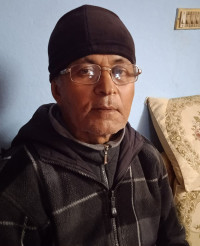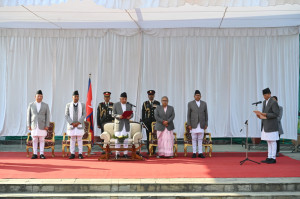National
Nepali parents lag behind in online safety conversation
Research shows while most parents are concerned about online risks, they lack the necessary knowledge, tools, or support to address them.
Aarati Ray
Parents are often seen as the first line of defence for children. But this role often weakens or becomes complicated when the threat comes through a screen.
While children scroll, swipe, and stream effortlessly like the natives of the digital realm, their parents, digital immigrants, lag behind, oblivious to the online risks and fumble through a world their kids have already mastered.
Take Misti, a 34-year-old mother from Harisiddhi, Lalitpur, who believed she was making a safer choice. Concerned about screen addiction, she chose not to give her 12-year-old daughter a personal phone. Instead, she allowed her to use her own phone for schoolwork.
“I was happy she stayed home and didn’t roam around like other kids,” said Misti, who the Post is identifying with a pseudonym for privacy.
What she didn’t realise was that danger had already entered her home, through her unlocked Facebook account. Her daughter, curious and unsupervised, explored the app, created her own profile, and began chatting with a stranger.
“I didn’t know she had her account…I’m not good with social media,” Misti admitted.
After six months, one night, Misti walked in to find her daughter nervously taking photos of herself under a blanket.
“I was shocked. She said her ‘boyfriend’ had sent her pictures and asked her to send some back,” Misti said. “Thank God I found out in time.”
“I never imagined something like this could happen,” she said. “I didn’t even know child sexual abuse could happen through a phone, nor could I think of someone to turn to for help.”
This incident highlights how parents are often left out of the conversation even while schools and organisations work to teach children about dangers lurking online. As a result, most guardians are unable or not ready to respond.
Research backs up this concern.
A recent mixed method study by ChildSafeNet, which surveyed 900 parents of children aged 6 to 17, held six focus group discussions with teens aged 13–17, and ten key informant interviews, found that while most parents are concerned about online risks, they lack the necessary knowledge, tools, or support to address them.
Cyber abuse cases targeting children have increased nearly fourfold in the past three years, from 176 to 706. Yet, among the parents surveyed, only 8 percent had a good understanding of online threats to children.
A startling 70 percent admitted they did not know what could expose children to sexual exploitation and abuse online. And 85 percent had never discussed topics like sexuality, sexual and reproductive health, or online abuse with their children.
“Unless parents are trained, resourced, and supported to understand the digital world their children inhabit, the gap in protection will only widen,” adds Disu Bhandari Manandhar, a parenting coach, child expert and educationist.
According to Pratima Lama, co-founder of Smart Parenting Nepal, while a few urban parents have an awareness of online risks, most others are uninformed. “Many have no idea threats like cyberbullying, online child sexual abuse exist or that the Police Cyber Bureau offers help.”
Lama adds that most Nepali parents rely on their children to navigate the internet and social media, unaware of what their children are doing.
Many even wrongly equate staying home with safety and provide phones to young children without any precautions, thinking it’s better than letting them go outside, says Manandhar, who is also a counsellor at Guhyeshwari Boarding High School and Occidental Public School.
The cause behind parents’ limited awareness is generational divide, low digital literacy, gaps in formal education, and the urban-rural divide, points Risohani Shrestha Pradhanang, a parenting education consultant.
This leaves parents treating social media like a harmless playground, freely sharing their children’s lives online (sharenting), putting their kids’ safety and privacy at risk.
Another reason why educating children alone about online safety is not enough is the common practice of children using their family members’ phones, says Lama. Research supports this.
Over half of the surveyed parents (55.4 per cent) reported that their children rely on family members’ phones and accounts to access the internet.
However, parents overlook that social media feeds and internet algorithms on these devices may not be appropriate for children.
Even if the content isn’t explicit, adults may watch shows, movies, music videos, or news about disturbing events that aren’t suitable for young viewers.
When children use the same devices, they’re exposed to content beyond their developmental age. Even simple tasks like googling for schoolwork can lead to explicit or provocative ads.
“I am always cautious when handing over phones,” says Nripesh Rajbhandari, a paediatric surgeon and father of two, aged 11 and 14.
Based on his experience, Rajbhandari says tools like parental controls on social media and internet safety features, such as Vianet’s ViaSecure, can be effective in filtering harmful content.
But, unlike Rajbhandari, very few parents are aware of such features.
Only 6 percent of the surveyed 900 parents reported using online safety or parental tools.
Moreover, the information on safety settings in social media and technology platforms is mostly in English, making it inaccessible.
That’s why, according to Manandhar, the first step in addressing online safety is raising awareness among parents about digital parenting.
Children, she points out, are at an age of heightened curiosity, egocentrism, and risk-taking. Even if they’re taught about online dangers, they often don’t take them seriously.
“Parents might not be tech-savvy like their children, but that doesn’t mean they can’t have meaningful conversations,” says Manandhar. “If they’re at least aware these risks exist, they’ll be able to protect their children better.”
Lama at Smart Parenting Nepal uses a three-step approach: first discussion with children, then involving parents, and finally uniting both. “This model strengthens online safety training and parenting,” she says, “and should be embraced by governments and key actors.”
Experts also suggest revising the government’s parenting programmes, like the ‘Parenting Education National Package’.
The package lacks a comprehensive digital safety and digital parenting framework, adds Pradhanang.
She also calls on the government to integrate community dialogues on digital parenting into policies and to strengthen awareness efforts in schools and local communities. “There should be sensitised and interactive awareness programmes beyond instructional PowerPoint lectures”.
“Digital parenting sessions should be as common as ‘good touch, bad touch’ programmes in schools,” adds Rajbhandari. “I requested one at my children’s school, and it helped. When choosing schools, we parents should consider such initiatives, beyond academic results.”
But experts warn that simply teaching parents technical skills or cyber dangers isn’t enough, as parents vary widely in their education level.
Pradhanang says parents should first learn soft skills like open communication and parenting style, as they require no formal education and build the foundation for digital safety.
Another reason, Pradhanang explains, is that children hide online abuse and problems out of fear of blame or punishment. Many also create separate accounts: one for family and relatives, and others on platforms like Instagram, Snapchat, Omegle, or Discord for their friends, keeping their online activity hidden from older generations.
So, the solution, Manandhar adds, is teaching parents to create an environment where children feel heard, respected, and safe to share. Without the right parenting approach, true online safety can’t be ensured.
Experts warn that extreme digital parenting, whether too strict or too lenient, can harm children emotionally, leading to withdrawal, depression, or even suicidal thoughts.
They recommend an ‘authoritative parenting’ style instead, which balances clear rules and high expectations with warmth and open communication.
Instead of unilaterally setting rules on screen time, parental controls, or app restrictions, Lama encourages parents to engage their children, explain the reasons behind the rules and involve them in the decision-making process.
Manandhar seconds that. The red flags children display, like withdrawal, aggression, and secrecy from phone use, aren’t just caused by technology; these are emotional cues, shaped by how parents have responded in the past. “Don’t blame social media alone. Reflecting on your parenting style is just as important,” she says.
Shrestha further adds that, as children can be perpetrators of hate speech or cyberbullying too, parents should teach them that empathy, values, and morality matter online just as much as offline.
As online risks evolve, governments and stakeholders must prioritise parents in online child protection by strengthening both technical skills, such as digital literacy, and soft skills, like authoritative parenting.
“Because no matter how much we educate children,” Lama says, “true online safety isn’t possible without informed, empowered, and well-equipped parents.”




 9.45°C Kathmandu
9.45°C Kathmandu






%20(1).jpg&w=300&height=200)








